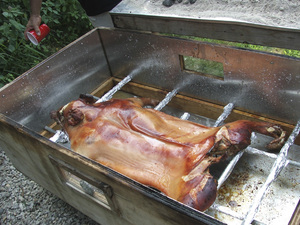“The first time I saw the box I said ‘I can build a better one’ and I did,” says Jesus Lima from his living room in Jamaica Plain, outside of Boston. A caja China or “Chinese box” is a metal-lined wooden box for roasting. Lima uses his to cook whole pigs. But you could cook a chicken, you could cook a fish, anything you want,” he says.
Ten years and ninety pigs ago, Lima, a former Cuban-refugee, built his box with pine. He used stainless steel to line the inside and the top of the box where the fire is built with coals. He calls his box la chinee. Commercially built Caja Chinas can be purchased on the Internet but Lima prefers his box. “The pig is too far away from the heat in those boxes,” he says.
His hands move fluidly when he speaks. In fact, though he’s sitting, it seems that every part moves when he speaks. He explains that traditional gatherings in Cuba center on roasting in a pit or on a spit. Roasting in boxes evolved as Cuban-Americans in Miami developed more resources. “They cook in them all the time in Miami. When we go see my family my brother cooks the pig. He is a very good cook.”
Roasting a whole pig is not for everyone. First you have to get one. “For me, it is no trouble,” says Lima.
The pig, ranging from 80-120 pounds, arrives split open down the belly, gutted and shaved. Lima prepares the pig the way he always has. First he pierces the skin with a sharp knife, careful not to go all the way through the flesh. The idea is to create pockets for marinade to permeate the meat with flavor. The pig soaks overnight in pungent mojo (mo-ho). For the mojo, Lima mixes garlic powder, onion powder, cumin, salt, black pepper, sour orange (also called “ugly fruit”), lemon, and oil. He adds sauce from a store-bought bottle to this homemade blend. “I don’t know what it’s called, it has the picture of a pig smiling on it.” He pours the mojo over the pig so that it fills the knife-slitted flesh and flows in, on and around the pig. “It should look like it’s swimming in this thing here,” he says.
On an August day, at a party in Westport, Massachusetts, two pigs roast. Chris Schlesinger, a James Beard award-winning chef and restaurateur, cooks his pig in an Internet-purchased La Caja China. Lima, a carpenter by trade, roasts another pig in his chinee. An unofficial contest is on.
“Come here and see! We are about to flip the pig,” says Lima. He and another man hold handles at each end of the box’s lid and lift it off. Careful not to disrupt the pile of hot coals held on the metal surface, they set the top on the ground. Inside the box, on a rack, lies the 90-pound pig, caramel in color, belly side up. A second rack is placed over the pig. Two long poles attach to the rack unit on each side. Flipping the beast means lifting the racked pig out of the box, turning it upside down, replacing it in the box, and taking off the upper rack. After brushing the skin with a mix of sugar and oil, the men replace the box top. The pig has been roasting for five hours. It cooks for three more.
At the other end of the yard, down a grassy hill, next to the east branch of the Westport River, the Schlesinger pig roasts for a total of four hours. To prepare his pig, Schlesinger first soaked it for a couple hours in brine of salted and sugared water. He then rubbed the pig with salt, pepper and cumin, and scored the pig’s skin to make it crispy by letting air in while the pig cooks.
The basic structure of the Internet-purchased roasting box is similar to Lima’s. But the details differ. Where Lima’s metal is stainless steel, Schlesinger’s is aluminum. The shape of the top tray holding the heat source warps under the hot coals. With Lima’s box the wood is more robust, the oven more impressive. The overall difference is that of an apple pie from the grocery store and one made from an old family recipe.
While the pigs cook, margaritas, beer and wine flow. A band sets up on a small stage under a tree, plugging in amps, testing equipment. A breeze swirls off the water and through the yard.
As the sun begins to set, orange and glowing, the pigs are ready.
Schlesinger serves his pig build-your-own taco style. Plates and bowls of flour tortillas, chopped red tomatoes, avocados, onion, cilantro and spicy sauces line the table. Slices and chunks of pork fill two large pans. Crispy pieces of browned skin fill another.
But this pork is dry, chewy to the point of toughness. Pork-filled tortillas become vehicles for the other, more flavorful components: the sweet and summery tomatoes, earthy black beans, bright and crisp cilantro, creamy avocado, and
lip-tingling spicy mango sauce. The sauce is hot enough to burn, good enough to like it.
The next table holds heaps of pork, fallen and pulled from the bone. Lima doesn’t believe in using a knife at a pig roast. “The way I learn how to cook a pig is that when you pick up a piece with your hand, meat will fall off the bone. It’s juicy and it’s tasty and I’ve never done it any other way. And I’ve done a lot of pigs,” he says. Piles of tender meat fill plates.
This pig, sumptuous as velvet, melts. This pig is perfect.
Lima’s sides include a large pot of mashed yucca – chunky and filled with garlic – big bowls of black beans and rice and a platter of fried plantains called tostones. To make tostones, green plantains are cut into inch-long pieces, fried quickly, taken out and smashed flat, then fried again. They are tossed hot with salt.
Sweet and crispy slices of pig skin go quickly. Called chicaron de porco, the skin has been described as “pig candy.” Kids clamor for it. “One more piece of chicaron, please, Mommy!” plead a little boy and girl. Adults just drool.
Night falls and light from fiery torches dots the yard. The banks of the Westport River cool when the sun goes down. A bonfire blazes. People gather, telling stories and drinking beer or wine from big plastic cups. Cover songs from Motown, disco, and hits from the 80s draw a crowd to the grassy area in front of the band. They dance and kiss in the dark while others watch, laughing.
Old friends, Schlesinger and Lima joke that there was no actual contest. It’s decided that the pigs were different, both were good. But months later, Lima says, “A lot of people like mine because it’s tastier, it’s softer. He will learn. He will learn more about this pig and it will be much better.”




